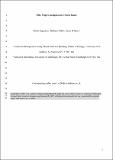Object manipulation without hands
Abstract
Our current understanding of manipulation is based on primate hands, resulting in a detailed but narrow perspective of ways to handle objects. Although most other animals lack hands, they are still capable of flexible manipulation of diverse objects, including food and nest materials, and depend on dexterity in object handling to survive and reproduce. Birds, for instance, use their bills and feet to forage and build nests, while insects carry food and construct nests with their mandibles and legs. Bird bills and insect mandibles are much simpler than a primate hand, resembling simple robotic grippers. A better understanding of manipulation in these and other species would provide a broader comparative perspective on the origins of dexterity. Here we contrast data from primates, birds and insects, describing how they sense and grasp objects, and the neural architectures that control manipulation. Finally, we outline techniques for collecting comparable manipulation data from animals with diverse morphologies and describe the practical applications of studying manipulation in a wide range of species, including providing inspiration for novel designs of robotic manipulators.
Citation
Sugasawa , S , Webb , B & Healy , S D 2021 , ' Object manipulation without hands ' , Proceedings of the Royal Society of London Series B: Biological Sciences , vol. 288 , no. 1947 . https://doi.org/10.1098/rspb.2020.3184
Publication
Proceedings of the Royal Society of London Series B: Biological Sciences
Status
Peer reviewed
ISSN
0962-8452Type
Journal article
Description
Funding: This work was supported by BBSRC Discovery Fellowship (BB/S01019X/1) to S.S.Collections
Items in the St Andrews Research Repository are protected by copyright, with all rights reserved, unless otherwise indicated.

